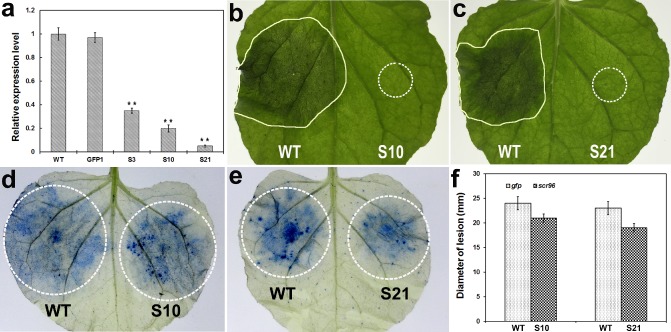Figure 4.

The role of P hytophthora cactorum scr96 in the infection of N icotiana benthamiana. (a) Silencing of scr96. The gene scr96 mRNA abundances in three stably silenced P . cactorum transformants (S3, S10 and S21) were determined by quantitative polymerase chain reaction (PCR) 3 days after mycelial growth in V8 medium relative to PcU bc mRNA abundances, and then normalized to the wild‐type isolate 10 300 (WT). GFP1 is a transformation control expressing green fluorescent protein. Standard errors from three technical replicates are shown. Statistical significance was analysed using Student's t‐test between the WT/GFP1 and WT/transformant comparisons (**P < 0.01). (b, c) Two representative gene‐silenced transformants (S10 and S21, respectively) show a loss in virulence on N . benthamiana compared with the WT. Photographs were taken at 48 h post‐inoculation (hpi). The irregular shaped areas are necrotic tissues caused by the WT isolate, whereas broken circles indicate the gene‐silenced transformant inoculation sites without visible necrosis. (d–f) Transient expression of scr96 partially recovered the virulence of gene‐silenced transformants on N . benthamiana. At 48 h after agroinfiltration, infiltration sites in each leaf expressing both gfp (left) and scr96 (right) were challenged with the WT isolate and gene‐silenced transformants [S10 (d) or S21 (e)]. Photographs were taken 48 h after pathogen inoculation. Leaves were stained by trypan blue and then destained by ethanol. The broken circles indicate the infiltration and inoculation sites. (f) The diameters of the lesions from (d) and (e) were measured and analysed. Error bars represent standard errors from technical replicates. There was no significant difference between left and right treatments (Student's t‐test).
